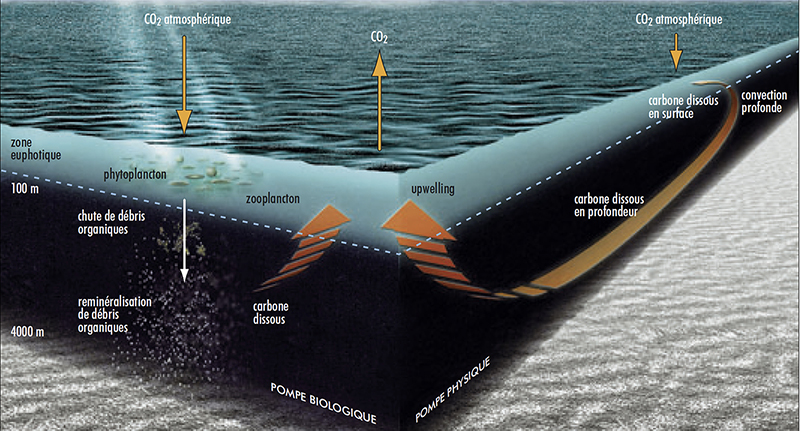DID PHYSICAL AND BIOLOGICAL PUMPS CAUSE VARIATIONS IN ATMOSPHERIC pCO2?

Measurements of CO2 trapped in the ice of the Antarctic reveal that pCO2 levels in the atmosphere during glacial periods were ~ 100 ppm less than the pCO2 levels recorded for interglacial periods before the advent of anthropic activity. Furthermore, studies show a close correlation between atmospheric pCO2, the volume of ice, and Antarctic temperatures, which suggests that pCO2 was a forcing or amplifying factor in glacial/interglacial cycles, and highlight the importance of the southern high latitudes in rapid paleoclimatic change. A key element in thermohaline circulation is the return route of deep water masses to the surface via the Antarctic Divergence. This mechanism, known as the “physical pump”, which is partly controlled by the latitudinal position and intensity of the westerly winds, influences the transfer of heat and carbon from the deep ocean reservoir to the ocean surface and the atmosphere, and has an impact at a global scale. Furthermore, in addition to this physical pump, there is also a “biological pump”, which corresponds to the transfer of particulate carbon (organic and inorganic) from the surface of the ocean to the deep ocean via the activity of primary producers and calcareous plankton respectively, which might explain a significant proportion of the changes in atmospheric pCO2 during the last deglaciations. However, up until now few studies have focused on the coupled action of physical and biological pumps in the past.
The aim of our research activities is to reconstruct the dynamics of upwelling and changes in the biological pump in the southern hemisphere over the last 800 ka so as to understand their impacts on past changes in atmospheric pCO2.
Doctoral students
Associated projects
Recent publications
Duchamp-Alphonse S, Siani G, Michel E, Beaufort L, Gally Y, Jaccard SL [2018] Enhanced ocean-atmosphere carbon partitioning via the carbonate counter pump during the last deglacial; Nature Communications 9:2396, doi: 101038/s41467-018-04625-7 (https://www.nature.com/articles/s41467-018-04625-7.pdf)
SEE MORE…
Haddam NA, Siani G, Michel E, Kaiser J, Lamy F, Duchamp-Alphonse S, Hefter J, Braconnot P, Dewilde F, Isgüder G, Tisnerat-Laborde N, Thil F, Durand N, Kissel C [2018] Changes in latitudinal sea-surface temperature gradients along the South Chilean margin since the last Glacial; Quaternary Science Reviews 194, 62-76 doi:org/101016/jquascirev201806023
SEE MORE…
Haddam NA, Michel E, Siani G, Cortese G, Bostock H, Duprat J M, Isguder G [2016] Improving past sea surface temperature reconstructions from the Southern Hemisphere oceans using planktonic foraminiferal census data; Paleoceanography 31(6), 822-837
SEE MORE …
Montade V, Kageyama M, Combourieu Nebout N, Ledru MP, Michel E, Siani G, Kissel C [2015] Teleconnection between the intertropical convergence zone and southern westerly winds throughout the last deglaciation; Geology 43(8), 735-7348
SEE MORE…
Van Daele M, Bertrand S, Meyer I, Moernaut J, Vandoorne W, Siani G, Tanghe N, Ghazoui Z, Pino M, Urrutia R, De Batist M [2016] Late Quaternary evolution of Lago Castor (northern Chilean Patagonia 46°S): lake formation and evolution of the southern westerlies during the last 17 kyr; Quaternary Science Review 133, 130–146
SEE MORE…
